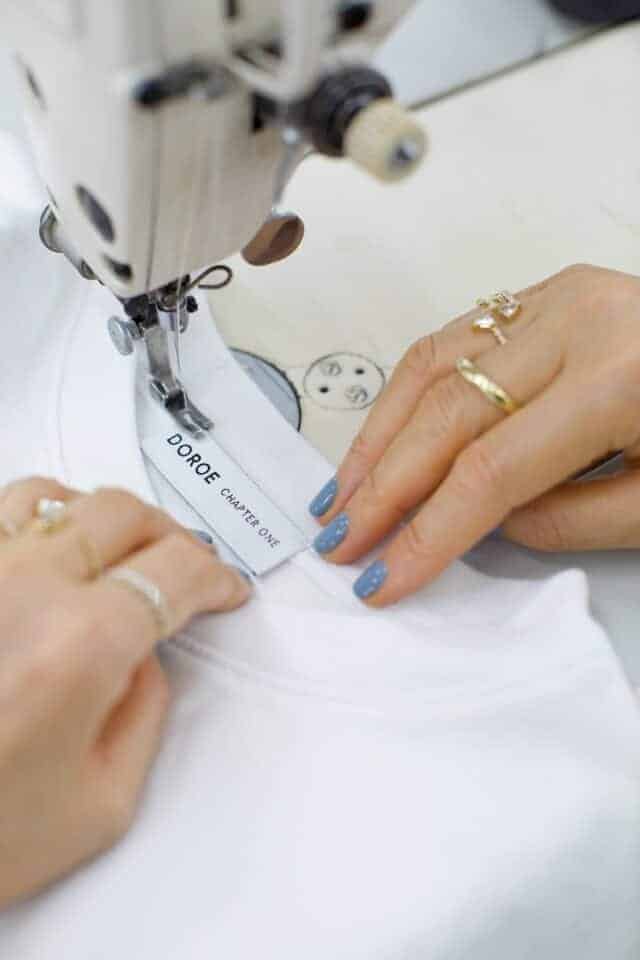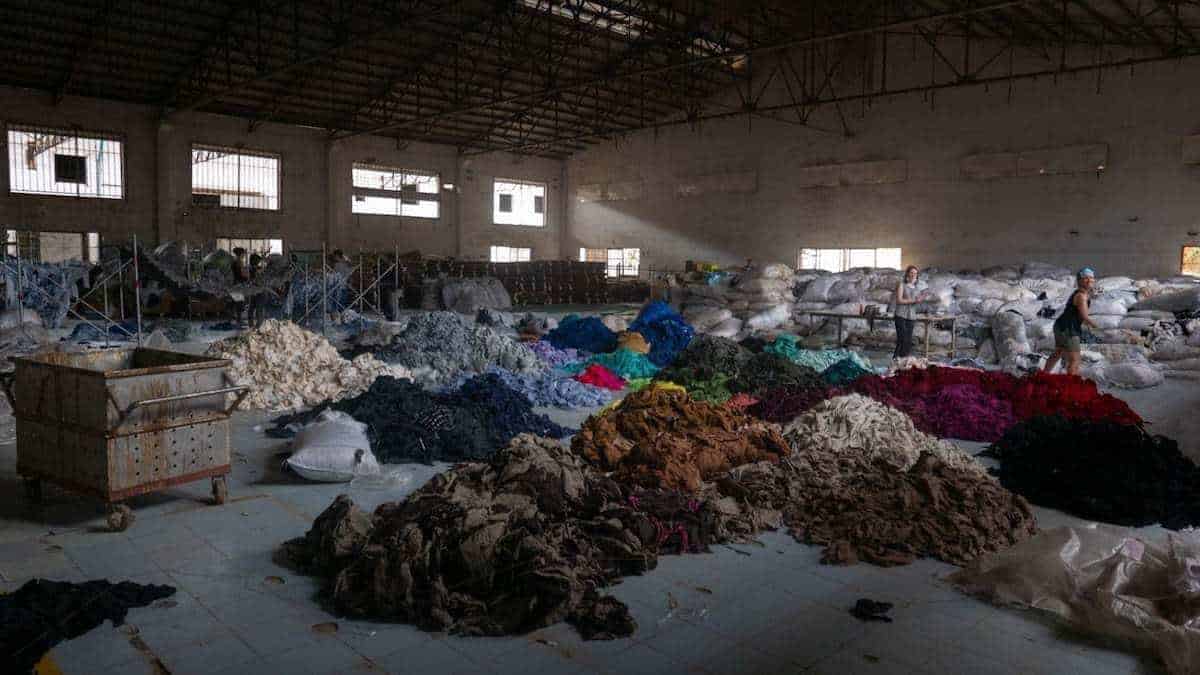
Consider the story of your favorite piece of clothing.
Maybe it’s a dress you wore to your best friend’s wedding or a t-shirt your favorite musician complimented when you met them at one of their shows. Maybe it’s a pair of pants you feel most like “you” when wearing, or a sweater you inherited from your grandpa.
Our clothing tells stories. You’ve probably looked back at an old picture of yourself and remembered the top you were wearing at the time… where you got it, how you felt when you put it on.
We don’t, however, always think about the person who began the story–the person who likely created the piece of clothing during one of their 12-hour work days, earning below minimum wage.
Most of us aren’t aware of the long journey our clothing takes before it is folded and placed on shelves. We don’t see the garments until they’re on display, so it’s easy to imagine our shirts, pants, socks, and coats appear there by magic. Of course, retail employees fold them by hand, hang them on racks, and wiggle them onto mannequins, but how does our clothing get made in the first place?
All garments are made by human hands.
Unlike many factory-made items, clothing isn’t created by machines. There are no assembly lines for sweatpants, no fully automated ways to bring a t-shirt into existence. While parts of the production process may be handled by machines, no clothing can be made without a person there to guide the stitches.
In other words, all garments are made by human hands.
It takes time and effort to create clothing. This is easy to forget when fashion is mass-produced and easily available. Clothing has gotten progressively cheaper over the years, making it even easier to dismiss the labor that goes into making a simple t-shirt. One pair of pants blends into the next, and the people who make them rarely cross our minds.
But people do make them, and those people are statistically likely to be underprivileged women of color who aren’t paid nearly enough for their efforts.
This injustice occurs in developing nations, yes, but it also happens right here, in the United States. An investigation into thirteen major retailers in Los Angeles (including TJ Maxx, Fashion Nova, and Urban Outfitters, among others) found wage violations in 85% of their factories, uncovering sweatshops who paid their workers as little as $5 per hour, violating basic labor laws.

The fashion industry is notorious for underpaying, overworking, and exploiting workers.
The percentage of fashion workers who earn a living wage is staggeringly low, at an estimated 2%. This issue has only grown since the onset of the COVID-19 pandemic, with many brands drastically cutting prices paid to factories. The result? Increased food insecurity and unfair dismissal of unionised workers.
Different from the minimum wage, a living wage allows a person to comfortably afford basic necessities. It’s determined by local prices for housing and utilities, transportation, food and water, healthcare, childcare, and education–essentials many garment workers struggle to afford.
How can this be, when fast fashion is a multi-trillion dollar industry? After all, Amancio Ortega, co-founder of Zara, is one of the wealthiest men in the world. Jin Sook and Do Won Chang, co-founders of Forever 21, are billionaires. With money like this, one would think they’d have no trouble paying their factory workers.
Still, they get away with it. Daily.

These brands sell their clothing at incredibly cheap prices, made possible by producing low-quality goods and severely underpaying their workers. These low prices are attractive to consumers, especially in a time when trends turn over more quickly than ever before. If your $8 t-shirt is out of style next month, no worries. You can just buy another one at little cost to you, right?
The cost is much bigger for those who made the t-shirt.
What can you do about it?
As a consumer, you have the power to shift the narrative.
Choosing to financially support brands who are 100% sweatshop free enables them to continue ethical business practices. Simultaneously, you withdraw financial support from unethical brands, creating a demand for them to produce their clothing more sustainably.
We won’t deny shopping for socially sustainable clothing is often more expensive than buying fast fashion. For many people, the most difficult part of changing their shopping habits is a shift in mindset. It’s incredibly normal–expected even–for the average person to purchase some of the cheapest clothing on the market. It’s hard to adjust your expectations to what an article of clothing should cost… but peace of mind comes with knowing the people who made those clothes were paid what they deserve.
If you evaluate your buying habits, you might notice you shop quite a lot already. It’s likely these habits need to change, which means your focus should shift to purchasing less items and shopping less often. Of course, this isn’t an all-or-nothing approach! Shopping sustainably still allows you to incorporate several new clothing items each season, so you can continue to feel excited about what you wear. (Thankfully, ethically-produced clothing tends to be higher quality and longer lasting, so you can get away with holding onto it for much longer than a cheaply produced sweatshirt from a fast fashion brand). Thrifting is a great option to source a portion of your wardrobe if some ethically-produced clothing is outside of your budget, and apps like Depop and Poshmark make it even easier to find secondhand clothing you like.
As more consumers begin to care about how their clothes are made, change will happen. More people will be paid fairly for their labor. Sweatshops–and the abundance of harm that comes from them–will eventually cease to exist.

Motivational speaker Denis Waitley once said:
“There are two primary choices in life: to accept conditions as they exist, or accept the responsibility for changing them.”
Change starts with you.
How do you know you’re supporting living wages?
Brands who pay their workers living wages are usually upfront about it.
ABLE and Nisolo started the lowest wage challenge, which asks brands to make public their lowest wages. A brand’s transparency doesn’t guarantee they’re paying all workers living wages, but it’s a step in the right direction and demonstrates a commitment to change. Publishing the lowest wage protects the most vulnerable workers–it’s much different than transparency surrounding the average wage.
Some brands, like Known Supply and Adelante Made-to-Order, even take it a step further by spotlighting the people who make their garments, giving visibility to the humans behind their clothes.
At Eco-Stylist, we recognize digging through the website of every clothing brand you like is tedious work and has the potential to be overwhelming… so we’ve done much of the work for you.
How can Eco-Stylist help?
We partner with brands held to high standards of Transparency, Fair Labor, and Sustainably Made, and they’re all listed on our website, making it easy for you to shop by your values. With little effort on your part, you can view which areas our brands excel in and where they have room for improvement.
While the brands we partner with aren’t perfect, they’re all committed to making positive change in our physical and social environments. Check out our shop page to find over 1,500 curated items from ethical brands that have made progress in providing living wages to their workers.
We recognize the shift toward sustainability is a continuous work-in-progress, and we’re committed to holding our partnered brands accountable to increasingly ethical practice.

Together, we believe we can write a new story for our clothing.
Together, we can create a world where garment workers are paid fairly and not overworked.
Together, we can ensure the story of your t-shirt is a good one–from start to finish.
More resources to check out

Celia Wiseman studied Communication and Creative Writing at the University of Iowa, and her growing interest in sustainable living led her to Eco-Stylist. In her free time she enjoys reading, writing, and making videos, as well as any other activity that allows her to get creative.









